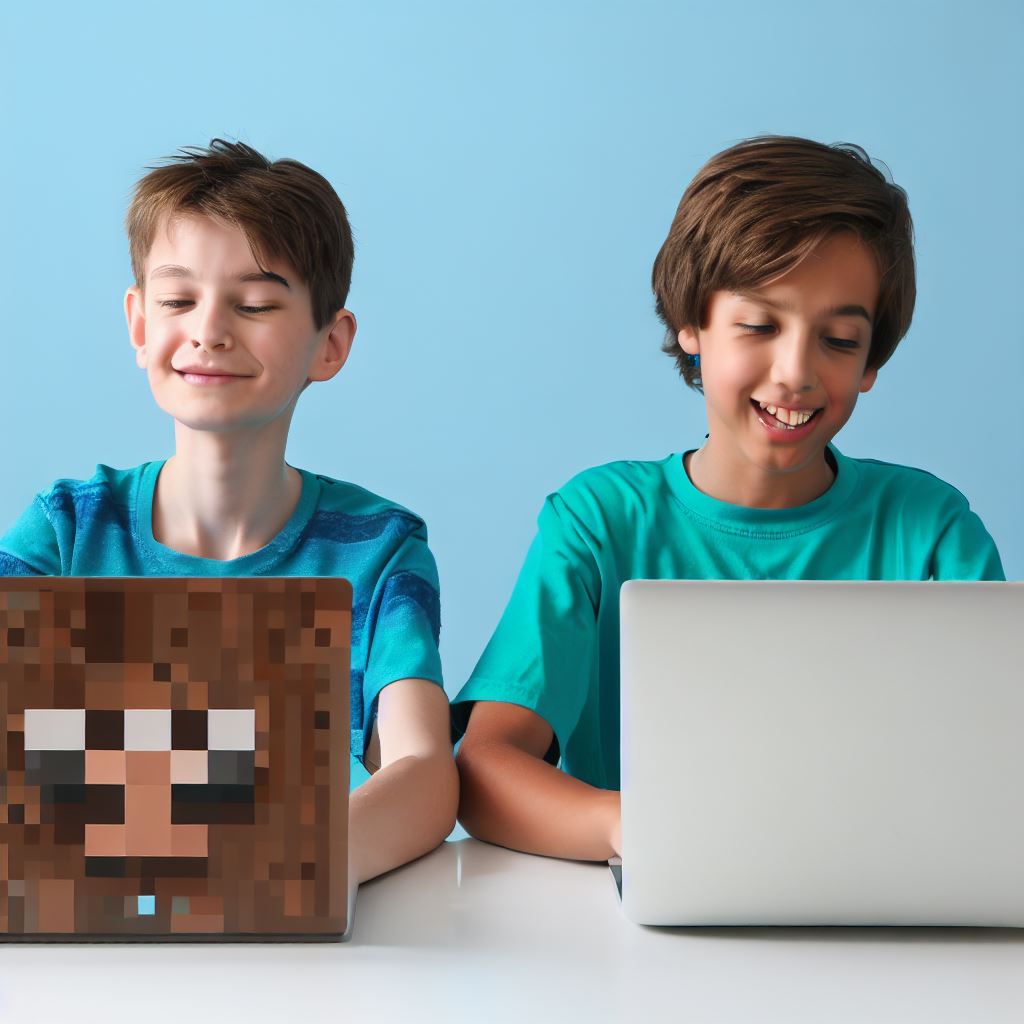Minecraft and Coding: Using Games to Teach Programming
Last Updated on January 27, 2024
Introduction
Coding has become increasingly popular and is now recognized as an essential skill in today’s digital world.
As technology continues to advance, the demand for programmers continues to grow.
With this importance in mind, educators and parents are seeking innovative ways to teach programming to children and young adults.
One emerging method is the use of games, particularly Minecraft, as a platform for learning coding skills.
A. Explanation of the growing popularity of coding and its importance
In recent years, coding has gained immense popularity due to its practical applications in various industries.
From software development to data analysis, coding skills are highly sought after by employers worldwide.
Additionally, the dynamic nature of coding allows individuals to express their creativity while problem-solving and building innovative solutions.
As technology continues to evolve, coding is becoming an increasingly necessary skill for individuals of all backgrounds.
B. Highlight the use of games as a platform for teaching programming skills
Games provide an immersive and engaging learning environment for individuals of all ages, making them an ideal platform for teaching coding skills.
Minecraft, in particular, has gained recognition for its ability to foster creativity and problem-solving abilities.
Through the game’s open-world environment, players can build, design, and manipulate virtual structures using blocks.
This process inherently involves logical thinking and sequential ordering, which are fundamental principles in coding.
By incorporating coding elements within games like Minecraft, educators can create a fun and interactive medium for teaching programming concepts.
Ultimately, this approach not only increases engagement but also enhances retention and understanding of coding principles among learners.
In essence, the growing popularity of coding has underscored its importance in today’s digital era.
Utilizing games, such as Minecraft, as a platform for teaching programming skills offers a unique and effective approach to engage and educate learners.
By integrating coding elements within games, educators can create an interactive and enjoyable learning environment that fosters creativity, problem-solving, and logical thinking.
Overview of Minecraft
Minecraft is a popular game that allows players to build and explore virtual worlds.
Its features include a survival mode, creative mode, and multiplayer options.
Children and teenagers are particularly drawn to Minecraft due to its open-ended gameplay and endless possibilities.
Educationally, Minecraft has been used to teach various subjects like math, science, and coding.
A. Brief description of the game and its features
Minecraft is a sandbox video game that was first released in 2011 by Mojang Studios.
Players are able to explore a 3D world made up of blocks, which they can manipulate and build.
The game offers two main modes: survival mode where players must gather resources, build shelter, and fight off enemies, and creative mode where players have unlimited resources to build whatever they want.
Minecraft also allows for multiplayer gameplay, where players can connect with friends and collaborate on projects.
Minecraft has achieved immense popularity, especially among children and teenagers.
Its simple graphics and gameplay make it accessible to a wide age range.
The game has sold over 200 million copies and has a large online community, with millions of players worldwide.
This popularity may be attributed to the game’s ability to foster creativity, problem-solving, and social interaction.
B. Educational aspects of Minecraft
Minecraft has gained recognition in the education field for its potential to support learning across various subjects.
- STEM Education: The game has successfully integrated STEM (Science, Technology, Engineering, and Mathematics) principles into its gameplay.
Minecraft also provides a platform for learning about coding, as players can use command blocks to create their own mini-games and programs. - History and Geography: Minecraft can be a useful tool for teaching history and geography. Players can recreate historical landmarks, explore different biomes, and understand the geographical features of our world.
Educators have used Minecraft to engage students in virtual field trips and historical reenactments. - Collaboration and Communication: Minecraft’s multiplayer mode enhances collaboration and communication skills.
Players can work together to build elaborate structures, solve problems, and share their knowledge. This cooperative aspect of the game encourages teamwork and fosters creativity and critical thinking. - Soft Skills Development: Through Minecraft, players can develop important soft skills such as creativity, problem-solving, and perseverance. The open-ended nature of the game allows for experimentation, enabling players to find innovative solutions to challenges they encounter.
Furthermore, Minecraft provides a safe and supportive environment where mistakes can be made and learned from.
In addition, Minecraft is a versatile game that offers educational benefits beyond entertainment.
Its popularity among children and teenagers can be attributed to its engaging gameplay and endless possibilities.
The game’s educational aspects encompass various subjects and skills, making it a valuable tool for teachers and learners alike.
Read: From Silicon Valley to NYC: Tracing the Footprints of Coding Ninjas
Minecraft as a Tool for Learning Programming
Minecraft has emerged as a valuable tool for teaching programming to both children and adults.
Through its open-world sandbox environment, players can engage in coding activities that enhance their problem-solving and critical-thinking skills.
By utilizing Minecraft as an educational platform, learners can acquire essential coding concepts and apply them in a practical and exciting context.
Players can also learn about algorithms and problem-solving by designing and building automated farms or contraptions in Minecraft.
These projects require players to plan and implement sequences of actions that accomplish specific goals.
By breaking down tasks into smaller steps and organizing them efficiently, players develop their algorithmic thinking skills.
They learn to analyze problems, devise strategies, and troubleshoot their designs, all of which are essential in programming.
Minecraft’s multiplayer feature opens up opportunities for collaborative coding activities. Players can work together to build complex structures or solve challenges that require coding knowledge.
This encourages teamwork, communication, and the sharing of ideas. It also simulates real-world coding scenarios, where developers often collaborate on projects to achieve common objectives.
Additionally, Minecraft offers resources such as Code Builder, an in-game tutorial system that introduces coding concepts through interactive lessons and challenges.
Code Builder provides an immersive and engaging environment for learners to acquire coding skills gradually.
Basically, Minecraft serves as an effective tool for teaching programming by providing a dynamic and interactive platform to learn and apply coding concepts.
Through activities like modding, redstone engineering, algorithm design, and multiplayer collaboration, players can develop vital problem-solving and critical-thinking skills.
By embracing the gamified approach to coding education, Minecraft helps make programming both accessible and enjoyable for learners of all ages.
Read: Diversity and Inclusion Initiatives in US Coding Schools

Benefits of Using Minecraft for Coding Education
When it comes to teaching programming, Minecraft has emerged as a powerful tool.
It not only provides an immersive and engaging environment, but also offers numerous benefits that can enhance students’ learning experience.
Some of these benefits include:
- Increased engagement and motivation among learners: Minecraft’s interactive and captivating gameplay appeals to students of all ages, encouraging their active participation in coding activities.
- Development of problem-solving and critical thinking skills: Minecraft presents students with complex challenges that require them to analyze problems, think critically, and use coding to find innovative solutions.
- Encouragement of creativity and collaborative learning: Minecraft’s open-world environment fosters creativity and allows students to experiment with coding concepts while collaborating with their peers.
By using Minecraft as a platform to teach coding, educators can tap into the following benefits in more detail:
A. Increased engagement and motivation among learners
Minecraft’s visually appealing and immersive gameplay captures students’ attention and keeps them actively engaged throughout the learning process.
The interconnectedness between coding and the game motivates students to learn and apply programming concepts to achieve in-game success.
This enhanced engagement can lead to a deeper understanding of coding principles.
B. Development of problem-solving and critical thinking skills
Minecraft’s gameplay is centered around solving puzzles and overcoming challenges, which promotes the development of problem-solving and critical thinking skills.
Students are required to employ coding techniques to find creative solutions, fostering a growth mindset and an ability to think outside the box.
As they encounter obstacles, they learn to analyze problems and identify the most efficient coding solutions.
C. Encouragement of creativity and collaborative learning
Minecraft’s open-world environment allows students to unleash their creativity and experiment with coding ideas in a virtual space.
They can build structures, modify the game mechanics, and create unique gameplay experiences using code.
Furthermore, Minecraft’s multiplayer mode promotes collaborative learning, as students can work together to brainstorm ideas, troubleshoot coding challenges, and share their creations with others.
In addition to these benefits, Minecraft offers a beginner-friendly learning curve, making it accessible to students with varying levels of coding experience.
The game’s block-based programming interface, known as “Redstone,” enables students to write code using visual blocks, making coding concepts easier to grasp.
This hands-on approach to learning coding fosters a deeper understanding of programming principles.
Moreover, Minecraft can be seamlessly integrated into existing curriculum, allowing educators to incorporate coding lessons across various subjects.
For example, students can use coding to enhance their understanding of geometry by building geometric structures in the game or simulate scientific experiments through coding.
This interdisciplinary approach to learning helps students see the practical applications of coding in real-world contexts.
Finally, Minecraft provides a unique and compelling platform for teaching coding.
Its engaging gameplay, emphasis on problem-solving, and promotion of creativity and collaboration make it an effective tool for educators.
By leveraging the benefits of Minecraft, educators can create an immersive and interactive learning experience that empowers students to become proficient programmers.
Read: From Coding Basics to Building Apps: A Comprehensive Path
Challenges and Considerations
A. Potential Challenges Faced when Using Minecraft for Coding Education
- Complexity of the game may overwhelm beginners.
- Learning curve for understanding game mechanics alongside coding concepts.
- Difficulty in managing large groups of students during collaborative coding sessions.
- Keeping students engaged and motivated throughout the learning process.
- Potential technical issues or glitches with the game itself.
B. The need for proper guidance and supervision
- Due to its open-ended nature, Minecraft requires guidance to focus on specific coding objectives.
- Teachers and instructors should provide clear goals and expectations for coding activities within the game.
- Ensuring students understand and follow ethical guidelines when coding within a communal game environment.
- Providing support and assistance to students when they encounter difficulties or obstacles.
- Offering feedback and assessment to guide students’ progress and development.
C. The importance of selecting appropriate educational resources
- Choosing coding resources that align with curriculum goals and learning outcomes.
- Selecting resources that are suitable for different age groups and skill levels.
- Ensuring the resources provide clear instructions and explanations of coding concepts.
- Using resources that offer interactive learning experiences and hands-on coding activities within the game.
- Seeking resources that foster creativity, problem-solving, and critical thinking skills.
Minecraft can be a powerful tool for teaching coding, but educators should carefully consider the challenges and considerations involved.
Providing proper guidance and supervision, along with selecting appropriate educational resources, will greatly enhance the effectiveness of using Minecraft for coding education.
Despite the potential challenges, the use of Minecraft can foster a unique and engaging learning environment, enabling students to develop important programming skills while having fun.
Resources and Tools for Using Minecraft for Coding Education
Using Minecraft as a tool for teaching coding not only makes learning more fun and engaging, but also helps develop critical thinking and problem-solving skills.
If you’re interested in incorporating Minecraft into your coding curriculum, here are some resources and tools that can assist you.
A. Websites
- Code.org: This website offers a variety of resources for learning coding, including Minecraft-themed coding puzzles and activities.
Link: www.code.org
Description: Code.org provides a user-friendly interface to introduce coding concepts through Minecraft-themed challenges. - Tynker: Tynker is an online learning platform that offers Minecraft coding courses for beginners.
Link: www.tynker.com
Description: Tynker provides step-by-step tutorials and interactive lessons to teach coding using Minecraft. - LearnToMod: LearnToMod is a platform specifically designed for coding within Minecraft.
Link: www.learntomod.com
Description: LearnToMod offers a wide range of coding courses for Minecraft, teaching JavaScript and Python programming.
B. Apps
- Minecraft: Education Edition: Developed specifically for educational purposes, this version of Minecraft allows students to learn coding directly in the game.
Link: www.minecrafteducationedition.com
Description: Minecraft: Education Edition provides an immersive environment for students to learn coding through block-based programming. - Scratch: Although not directly related to Minecraft, Scratch is a popular visual programming language that can be used alongside Minecraft projects.
Link: scratch.mit.edu
Description: Scratch allows users to create interactive stories, games, and animations, which can be integrated with Minecraft creations. - Blockly: Blockly is a visual programming editor that can be used in conjunction with Minecraft to teach coding concepts.
Link: developers.google.com/blockly
Description: Blockly offers a drag-and-drop interface to create programs for Minecraft, making it accessible for beginners.
C. Coding Languages and Platforms
- JavaScript: JavaScript is a versatile programming language that can be used to create mods, plugins, and extensions for Minecraft.
Description: JavaScript enables students to modify game mechanics, add new features, and create interactive elements within Minecraft. - Python: Python is a popular programming language for beginners, and it can be used to script mods and automation in Minecraft.
Description: Python offers a readable and clean syntax, making it an excellent choice for students learning coding through Minecraft. - Raspberry Pi: Raspberry Pi is a low-cost mini-computer that can be used to program Minecraft, allowing for more advanced coding projects.
Description: By connecting a Raspberry Pi to Minecraft, students can build complex systems and experiment with physical computing.
In general, Minecraft provides a unique and immersive platform for teaching coding, and there is a wide range of resources and tools available to assist educators in incorporating Minecraft into their coding curriculum.
Whether through websites, apps, or coding languages like JavaScript and Python, students can enhance their coding skills while enjoying the creativity and problem-solving aspects of Minecraft.
Start using Minecraft as a teaching tool and watch your students excel in coding!
Read: Financial Aid and Scholarships at Top Coding Academies
Success stories and examples
Using Minecraft as a tool for teaching programming has shown great success and has been embraced by various individuals and organizations.
Here are some inspiring success stories and examples:
A. Case study of a coding education program
One organization, CodingKids, implemented a coding education program using Minecraft.
They reported remarkable results, with students showing increased interest and engagement in learning coding concepts.
B. Achievements of students
Several students have harnessed the power of Minecraft to learn coding effectively.
For instance, Sarah, an 11-year-old, started coding within Minecraft and gradually developed her own game using various programming techniques.
David, a teenager passionate about coding, participated in a Minecraft coding competition and won first place for his intricately designed and functionally interactive virtual world.
C. Real-life examples of coding projects
Minecraft offers limitless creative opportunities for coding projects.
A notable example is the creation of a fully operational virtual roller coaster, complete with physics-based mechanics and interactive elements.
Another impressive project involves the development of a functional transportation system within Minecraft, where players can use coded commands to select destinations and navigate through the virtual world.
A group of students collaborated to build a massive virtual city, incorporating complex coding techniques.
They programmed automated traffic lights, simulated weather patterns, and even created an interactive marketplace where players could engage in virtual commerce.
The success stories and examples mentioned above highlight the effectiveness of using Minecraft for coding education.
It not only sparks interest but also empowers students to actively engage in learning complex programming concepts.
By providing real-world examples of coding projects within the game, students can see the practical applications of their coding skills and feel a sense of accomplishment.
Whether it’s through individual case studies or collective projects, Minecraft proves to be a valuable tool for teaching programming, fostering creativity, and nurturing problem-solving skills.
Uncover the Details: Coding vs Scripting: Definitions and Key Differences
Conclusion
Minecraft offers numerous benefits and potential for teaching programming.
By engaging students in a gamified learning experience, Minecraft helps them develop problem-solving skills, creativity, and critical thinking abilities.
Its sandbox environment allows students to experiment, iterate, and collaborate on coding projects.
Using Minecraft as a tool for coding education is a great way to make programming more accessible and enjoyable for learners of all ages.
It provides a hands-on approach where students can see immediate visual feedback of their code in action.
This makes the learning process more engaging and encourages students to explore and experiment further.
In the digital age, gamified learning experiences like Minecraft are crucial for capturing the attention and interest of learners.
Traditional teaching methods may not be as effective in holding the attention of tech-savvy students.
By incorporating gaming elements into education, we can tap into their natural inclination towards technology and leverage it for their learning benefit.
If you’re interested in teaching programming or want to learn coding yourself, I encourage you to explore Minecraft as a valuable educational tool.
With its immersive world and game mechanics, Minecraft can make the process of learning and practicing programming concepts exciting and enjoyable.
Minecraft provides a unique and valuable avenue for teaching programming.
Its potential to engage and motivate learners, along with the benefits of gamified learning experiences, make it a compelling tool for educators and students alike.
So, go ahead, embark on your coding journey through the Minecraft world!


